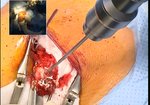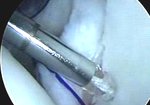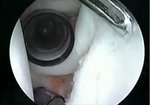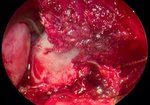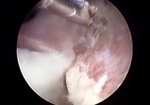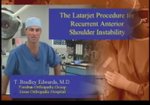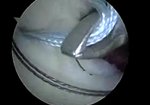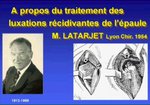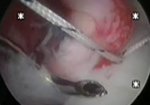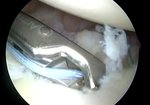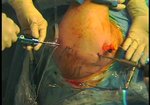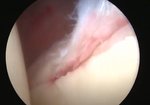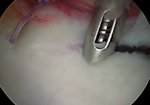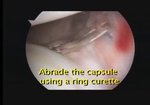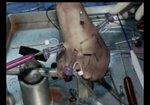Playback speed
10 seconds
Ancient Shoulder Dislocations Treated with Circumferential Capsular Release and Scapular-Sided Cuff Mobilization: Cadaver Dissection.
2,505 views
October 31, 2012
Ancient Shoulder Dislocations Treated with Circumferential Capsular Release and Scapular-Sided Cuff Mobilization.
Duane Anderson MD ...
read more ↘ (1), Lucas Anderson MD (2), Stephen K. Aoki MD (2)
1) Soddo Christian Hospital, Soddo, Ethiopia.
2) University of Utah, Department of Orthopaedics, Salt Lake City, Utah, USA.
Background:
Chronic shoulder dislocations are rare but difficult problems to address surgically. The capsule and rotator cuff become externally contracted while the humeral head becomes osteopenic and susceptible to collapse when relocated. We describe our experience and evolving surgical approach with shoulder dislocations ≥ 6 weeks. Shoulder preservation was favored over arthroplasty given patients’ ages and/or availability of arthroplasty implants.
Methods:
We retrospectively reviewed the surgical procedures and clinical outcomes of 6 patients with chronic anterior subcoracoid shoulder dislocations. Five patients had ancient (>12 weeks) dislocations and one patient had a late (6 weeks) dislocation. One woman, patient 6, was lost to follow-up. The other five patients were men with an average age of 33 years old (range 18-75). Average time to relocation was 4 months (range 1.5 - 6 months). Patients presented with complaints of an external rotation contracture limiting motion in front of their body and mild pain.
Patients 1 and 2 were relocated with circumferential release of the capsule alone. Patient 5 was treated with circumferential capsular release and limited posterior rotator cuff mobilization. Patients 3, 4, and 6 were treated with circumferential release of the shoulder capsule and aggressive scapular sided mobilization of the contracted rotator cuff.
Results:
Intraoperative findings included external rotation ankylosis with fixed engagement of the Hill-Sachs lesions in all six patients and a complete subscapularis avulsion in the female patient. Patients 1, 2 and 5 treated with limited cuff mobilization suffered humeral head collapse. Patient 1 and 5 had collapse intraoperatively after relocation and during attempts to regain internal rotation by manipulation respectively. Patient 2 suffered collapse within the first week of surgery. Humeral head collapse did not occur in patients 3, 4, and 6 who had aggressive scapular-sided cuff mobilization.
At 6 months follow-up, patients with collapse had limited forward elevation (30 degree average) compared to those without collapse (80 degree average), external rotation to neutral compared to 20˚, but comparable internal rotation with the arm at the side. Favorably, patients who suffered collapse benefited clinically with a stable reduced shoulder with an improved functional position of the arm and hand compared to the preoperative externally rotated position. Pain and functional outcomes were satisfactory in both shoulders with and without collapse.
Conclusions:
Our evolving technique demonstrated that both circumferential capsular release and aggressive scapular-sided posterior rotator cuff mobilization may be important to minimize risk of humeral head collapse and regaining functional motion and hand position in patients suffering chronic anterior shoulder dislocations. Further evolution of this labor-intensive technique is needed to improve salvage rates of the native shoulder in patients suffering ancient anterior shoulder dislocations.
↖ read less
Duane Anderson MD ...
read more ↘ (1), Lucas Anderson MD (2), Stephen K. Aoki MD (2)
1) Soddo Christian Hospital, Soddo, Ethiopia.
2) University of Utah, Department of Orthopaedics, Salt Lake City, Utah, USA.
Background:
Chronic shoulder dislocations are rare but difficult problems to address surgically. The capsule and rotator cuff become externally contracted while the humeral head becomes osteopenic and susceptible to collapse when relocated. We describe our experience and evolving surgical approach with shoulder dislocations ≥ 6 weeks. Shoulder preservation was favored over arthroplasty given patients’ ages and/or availability of arthroplasty implants.
Methods:
We retrospectively reviewed the surgical procedures and clinical outcomes of 6 patients with chronic anterior subcoracoid shoulder dislocations. Five patients had ancient (>12 weeks) dislocations and one patient had a late (6 weeks) dislocation. One woman, patient 6, was lost to follow-up. The other five patients were men with an average age of 33 years old (range 18-75). Average time to relocation was 4 months (range 1.5 - 6 months). Patients presented with complaints of an external rotation contracture limiting motion in front of their body and mild pain.
Patients 1 and 2 were relocated with circumferential release of the capsule alone. Patient 5 was treated with circumferential capsular release and limited posterior rotator cuff mobilization. Patients 3, 4, and 6 were treated with circumferential release of the shoulder capsule and aggressive scapular sided mobilization of the contracted rotator cuff.
Results:
Intraoperative findings included external rotation ankylosis with fixed engagement of the Hill-Sachs lesions in all six patients and a complete subscapularis avulsion in the female patient. Patients 1, 2 and 5 treated with limited cuff mobilization suffered humeral head collapse. Patient 1 and 5 had collapse intraoperatively after relocation and during attempts to regain internal rotation by manipulation respectively. Patient 2 suffered collapse within the first week of surgery. Humeral head collapse did not occur in patients 3, 4, and 6 who had aggressive scapular-sided cuff mobilization.
At 6 months follow-up, patients with collapse had limited forward elevation (30 degree average) compared to those without collapse (80 degree average), external rotation to neutral compared to 20˚, but comparable internal rotation with the arm at the side. Favorably, patients who suffered collapse benefited clinically with a stable reduced shoulder with an improved functional position of the arm and hand compared to the preoperative externally rotated position. Pain and functional outcomes were satisfactory in both shoulders with and without collapse.
Conclusions:
Our evolving technique demonstrated that both circumferential capsular release and aggressive scapular-sided posterior rotator cuff mobilization may be important to minimize risk of humeral head collapse and regaining functional motion and hand position in patients suffering chronic anterior shoulder dislocations. Further evolution of this labor-intensive technique is needed to improve salvage rates of the native shoulder in patients suffering ancient anterior shoulder dislocations.
↖ read less
Comments 1
Login to view comments.
Click here to Login

